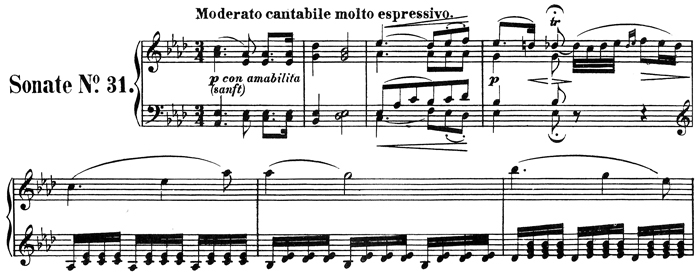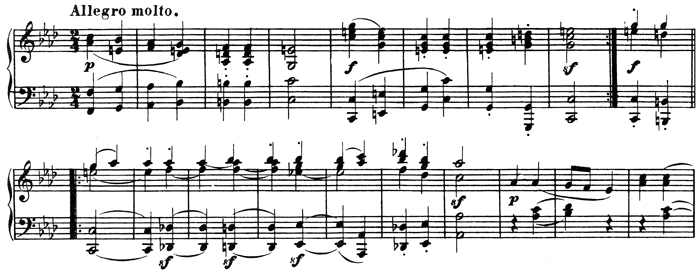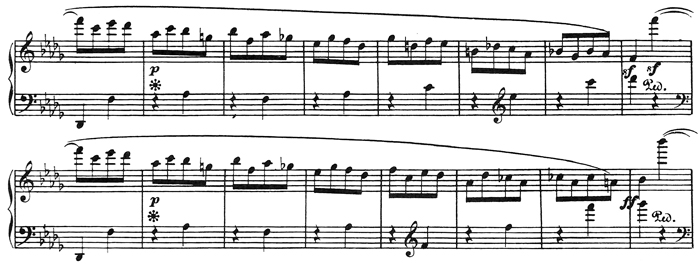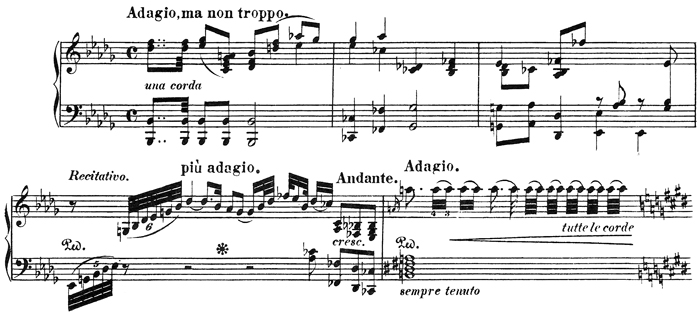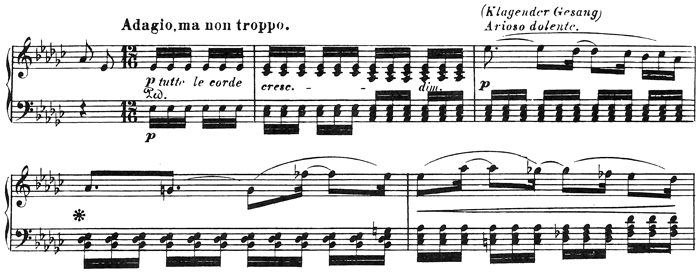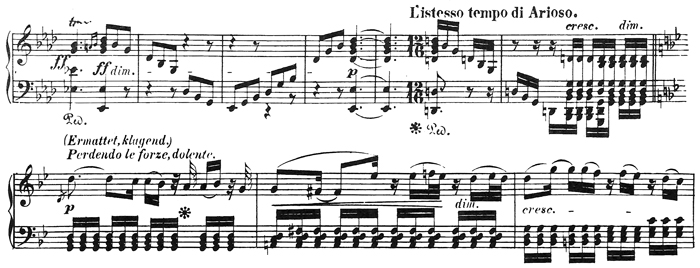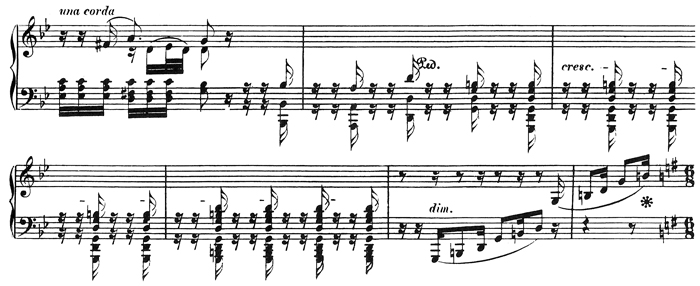Ludwig van Beethoven
Piano Sonata No.31 in A♭ major, op.110
Media Review / Comparison
2015-05-27 — Original posting
2015-08-20 — Added reference to Brautigam’s complete sonata recording
2016-08-04 — Brushed up for better readability
2022-07-02 — Corrected recording date for Artur Schnabel
Table of Contents
Introduction / The Recordings
This posting is one of a series covering the recordings of Beethoven’s piano sonatas in my music collection, about the Piano Sonata No.31 in A♭ major, op.110 — references to the CDs are given in the respective section or in one of the related postings. For links to all related postings see “Beethoven: Piano Sonatas, Summary“. I currently have 10 recordings, shown here sorted by recording date:
- Artur Schnabel (1933)
- Svjatoslav Richter (1965)
- Wilhelm Backhaus (1966)
- Friedrich Gulda (1967)
- Paul Badura-Skoda (1969)
- Maurizio Pollini (1976)
- Daniel Barenboim (1984)
- Emil Gilels (1985)
- Ronald Brautigam (2008)
- Igor Levit (2013)
Backhaus, Gulda, Pollini and Schnabel were also present in my LP collection. The others were added as CDs only, in order to have a broader scope for the comparison. Igor Levit is the latest addition. I added his recording on the occasion of Levit’s concert performance in Zurich.
Background, About the Composition
Ludwig van Beethoven (1770 – 1827) wrote the Piano Sonata No.31 in A♭ major, op.110, in 1821 — in terms of piano compositions, “only” the sonata op.111, the Diabelli Variations (op.120) and two sets of Bagatelles (op.119 and op.126) were to follow.
The Movements:
In this sonata, two large movements surround a short, Scherzo type movement:
I. Moderato cantabile molto espressivo (3/4)
The first movement is annotated Moderato cantabile molto espressivo — formally, it is a sonata movement with exposition (39 bars), a development section (16 bars), a recapitulation (49 bars) and a Coda (12 bars), but it lacks a distinct (“classic”) first and second theme of 8, 16 or 32 bars: it rather works with “theme fragments”. The first theme fragment is just 4 bars and opens the movement, whereby the last bar leads over to the next theme, a very nice melody with semiquaver accompaniment:
That melody just last 7 bars and is followed by an 8-bar demisemiquaver cascade, followed by “sort of” a second theme of 8 bars, which again is broken up into two 4-bar periods, where the second part can be seen as transition to a third theme of 10 bars. the development period primarily works with material from the initial 4 bars; the recapitulation is following anything but the classic idea of a harmonic variation of the exposition — it does roughly follow the exposition, but also freely combines / associates material from the various theme fragments. Overall, more of a fascinating fantasy than a rigid sonata movement.
II. Allegro molto (2/4)
The second movement has Scherzo character, in AABB – C – ABB-Coda form, whereby “A” is 8 bars, “B” is 32 bars; here’s the start of the movement with the “A” part and the first bares of “B”:
The “C” Part is mostly a sequence of 8-bar periods with quaver cascades ending in syncopated crotchet sforzati:
After the final repetition of the “B” part, the movement suddenly switches to a short, unexpected Coda that ends in a “ritardando question mark or colon”, supposed to open the expectation for the final movement, although there is no indication of an attacca:
III. Adagio, ma non troppo (4/4) — Arioso dolente (12/16) — Fuga. Allegro, ma non troppo (6/8) — L’istesso tempo di arioso (12/16) — L’inversione della fuga (6/8)
The third and last movement is big and multi-faceted. One might think that the lead-out Coda in the preceding movement allows the composer to start the next movement in medias res — but not only is there no attacca indication, as mentioned, but that last movement starts with an introduction in B♭ minor, initially Adagio ma non troppo, but then interrupted with a recitativo bar (più adagio, ending in a brief Andante), followed by another Adagio, where a bar of more & more rapidly repeated notes (a” flat) in the right hand modulates to the dominant of E major, then leads into another recitativo bar (Meno adagio, then Adagio), which ends diminuendo smorzando, arriving in E♭ minor —
just to be followed by a 20-bar Recitativo accompagnato (of sorts) in 12/16 (Adagio ma non troppo), annotated Klagender Gesang, Arioso dolente (i.e., mourning song):
Fugue
And only after these 26 bars of a dramatic, expressive opening, we finally arrive at an impressive, three-part fuga in A♭ major (6/8), Allegro ma non troppo:
The fugue builds up into a stretta culmination, but then falls down into broken chords that lead into another Arioso (L’istesso tempo di Arioso), annotated Ermattend klagend, Perdendo le forze, dolente (losing forces, mourning), about the same length as the first Arioso, but this time in G minor, again 12/16:
Towards the end, this Arioso loses all remaining forces, ending in a diminuendo, una corda — just to move into a miraculous transfiguration, with a set of chords, crescendo, implicitly written staccato, but with the sustain pedal kept down, modulating to G major:
and then there’s another fugue, with the same theme as the first one, but inverted:
this fugue does not start firmly or forceful, but una corda and p, but slowly reviving. After an episode in G minor, the music definitely brightens up to A♭ major, building up from a Meno allegro section,
ending a glorious, jubilant, joyful, almost ecstatic, final culmination — truly per aspera ad astra!
The Interpretations, Overview
In order to provide a rating overview, as well as an idea about tempo relations both within an interpretation, as well as between the two recordings, I have prepared the table below. For each artist, the upper row is the rating (gray=1, yellow=3, orange=5), the lower row shows the tempo, with color coding (blue = slower, white = average, green = faster):
The metronome readings are approximate.
The Interpretations, Detail
With most pianists in this review (Wilhelm Backhaus, Paul Badura-Skoda, Daniel Barenboim, Ronald Brautigam, Friedrich Gulda, and Artur Schnabel) I have their (or one of their) complete recording(s). Emil Gilels’ recording unfortunately remained unfinished, and Maurizio Pollini has only just released his complete set of Beethoven sonatas — the recording discussed here is part of his legendary set recorded in 1976, with the late Beethoven sonatas.
Wilhelm Backhaus (1966)
Beethoven: The 32 Piano Sonatas
Decca 473 7198 (8 CDs, mono / stereo); ℗ 1953 – 1969 / © 2006
Booklet: 28 pp. e/f/d

For general information on Wilhelm Backhaus‘ complete recording of all Beethoven piano sonatas see the post “Beethoven: Piano Sonata No.15 in D major, op.28“. This sonata was recorded 1966.
Notes on the Movements
I. Moderato cantabile molto espressivo (3/4)
Duration: 5’24”
The amount of arpeggiando playing in this interpretation is hardly bearable, and so is the extreme rubato; yes, there is flow in individual sections, but overall, this feels like a constant rollercoaster; also, Backhaus has sense for drama and the overall, big arches — but the Zeitgeist (or is this just Backhaus’ personal interpretation??) makes it hard to enjoy this interpretation.
II. Allegro molto (2/4)
Duration: 2’04”
Better tempo than Barenboim and Gilels, but with substantial rhythmic superficialities, particularly in the quavers, which often appear rushed (“B” part) or worse (“C” part).
III. Adagio, ma non troppo (4/4) — Arioso dolente (12/16) — Fuga. Allegro, ma non troppo (6/8)
Duration: 9’06”
Backhaus sticks to the “non troppo” in the annotation, avoiding excessive slowness — and similar to Svjatoslav Richter, the first bars feel slightly “suspended”, undetermined, as if the artist was still making up his mind about the tempo. The subsequent Recitativo up to the Andante is rather metric (not “vocal” enough, I think), and in the repeated notes in the Adagio, Backhaus binds each pair (except for the last one) into a single note. This ignores Beethoven’s “4-3” fingering instruction, which most other artists interpret such that both notes ought to be played, but with different weight (where the second note in each pair is like the echo to the first one).
Then, for today’s ears, there’s a bit too much of a delay between the accompaniment (left hand) and the melody in the Arioso parts, which are at the same time fairly metrical in the right hand / melody. That delay is sometimes also present in the fugues, but to a lesser degree — the dominating impression in these fugues is that of a strong interpretation / tempo concept, with excellent build-ups — with one restriction: I don’t quite understand Backhaus’ transition to the “Meno allegro /Etwas langsamer“: Backhaus slows down in the bars before that annotation, and where Beethoven instructs “slower”, he picks up the tempo again already — rather 5 bars later, where Beethoven writes “poco a poco più moto / nach und nach wieder geschwinder“.
Overall Duration: 16’33“
Rating (see above for details): 2.5 — An interesting historic interpretation, often impressive — as long as you tolerate some Zeitgeist.
Paul Badura-Skoda (1969)
Beethoven: The 32 Piano Sonatas
Paul Badura-Skoda (Bösendorfer 290 Imperial)
Gramola 987 42/50 (9 CDs, stereo)
Booklet: 20 pp. d/e/f/Japanese

For general information on Paul Badura-Skoda‘s complete recording of all Beethoven piano sonatas see the post “Beethoven: Piano Sonata No.15 in D major, op.28“. This sonata was recorded 1969, on a Bösendorfer 290 Imperial.
Notes on the Movements
I. Moderato cantabile molto espressivo (3/4)
Duration: 6’11”
Given the instrument that Badura-Skoda plays, one certainly should not have to complain about poor sonority. In the upper registers, the instrument is sounding bright, singing, yet somewhat mellow in the middle range. Sometimes, the bass appears over-enhanced in this recording — e.g., in the development phase, where some of the bass lines sound as if they were shifted down by an octave — this makes these passages sound a bit out-of-balance. The artist avoids covering rests by excessive use of the sustain pedal. Badura-Skoda plays with careful phrasing and articulation — it’s just that I personally find it emotionally a bit “dry”, occasionally lacking some rhythmic freedom.
II. Allegro molto (2/4)
Duration: 2’09”
Good tempo and rhythmic control — maybe a little too “big”, “imperial” (!), i.e., not considering Beethoven’s instrumental scope?
III. Adagio, ma non troppo (4/4) — Arioso dolente (12/16) — Fuga. Allegro, ma non troppo (6/8)
Duration: 9’10”
Badura-Skoda’s piano touch in the introduction (beginning) is slightly arpeggiando, is at the limit of sounding sluggish. The first Arioso section has a good tempo (among the fastest in this comparison), really allowing for the melodies to sing; but to me, there’s too much occasional arpeggiando (fairly often, the melody is slightly lagging behind). I don’t see a clear, logical / convincing tempo concept, and to me, the transitions are not conclusive.
Overall Duration: 17’27“
Rating (see above for details): 3.0 — A good interpretation in the first two movements.
Daniel Barenboim (1984)
Beethoven: The Piano Sonatas Nos.16 – 32
DG 413 766-2 (6 CDs, stereo); ℗ 1984
Booklet: 50 pp. d/e/f

For general information on Daniel Barenboim‘s complete recording of all Beethoven piano sonatas see the post “Beethoven: Piano Sonata No.15 in D major, op.28“. This sonata was recorded 1984.
Notes on the Movements
I. Moderato cantabile molto espressivo (3/4)
Duration: 7’34”
Played diligently, but slow and heavy in general; in the transition to the development section, Barenboim adds an extreme rallentando which I think is hardly justified, particularly, as Beethoven has already “composed” an implicit rallentando into the music. With this tempo, particularly in the development phase, the music is in danger of losing tension and drama. An attempt to make the music bigger, heavier than it is?
II. Allegro molto (2/4)
Duration: 2’21”
Way too heavy and slow: definitely not Allegro, let alone Allegro molto (Allegro meaning joyful!); in the “C” part, the syncopes are even clumsy, actually losing their syncope character.
III. Adagio, ma non troppo (4/4) — Arioso dolente (12/16) — Fuga. Allegro, ma non troppo (6/8)
Duration: 12’12”
The beginning (Adagio ma non troppo) is way too slow. I would even call this “senza tempo“, i.e., slower than Lento: Adagio means calm, not slow! And the Recitativo part is supposed to sound vocal. The same applies to the subsequent Arioso dolente, in the Adagio ma non troppo part, as well as to the second major recitativo part after the first fugue (L’istesso tempo di arioso). The melody is stretched beyond recognition. The tempo in the fugues is better, bus still somewhat on the slow side. Too bad he is so much off in the tempo for the slow parts — apart from this (important) aspect, Barenboim’s playing isn’t really bad, and his final build-up in the second fugue is quite harmonic and impressive.
Overall Duration: 22’05“
Rating (see above for details): 2.0 — Technically, Barenboim’s playing is quite OK (also the sound of the instrument and the of recording are OK). If only he were to play at a decent tempo.
Ronald Brautigam (2008)
Beethoven: Piano Sonatas opp.101, 109, 110, 111
Ronald Brautigam (Fortepiano by Paul McNulty, 2007, after Conrad Graf, ca.1819)
BIS-SACD-1613 (SACD/CD); ℗ / © 2010
Booklet: 28 pp. e/d/f

Beethoven: The Complete Piano Sonatas
Ronald Brautigam (Fortepiani by Paul McNulty)
BIS-SACD-2000 (9 SACD/CD); ℗ 2004 – 2010 / © 2014
Booklet: en/de/fr

This is the last of the sonata CDs in Ronald Brautigam‘s (*1954) complete recording of all of Beethoven’s works for piano solo. This was recorded in 2008, on a fortepiano built by Paul McNulty (2007), after an instrument (opus 318) by Conrad Graf, from ca.1819 — a piano model that was also delivered to Beethoven in 1825. The instrument features una corda, single and double moderator, and sustain pedals and has a tonal range of CC up to f””.
Notes on the Movements
I. Moderato cantabile molto espressivo (3/4)
Duration: 5’49”
I was curious to see how this interpretation would fare against “big” ones such as Pollini’s. And I was pleased to see that this recording doesn’t need to hide behind any of the others, even though (maybe also: because) it is hardly comparable: I sense myself thrown into a different world, as the instrumental / tonal balance is totally different (and this was the sound world that the composer was thinking / living in!).
First, the sound as such alone is already stunning in its richness and clarity, its liveliness. Everything receives a totally different weight in this instrument (compared to a modern concert grand): trills, scales, runs and repeated notes (such as the evolving repeated chords at the end of the evolution) stand out more, the bass register is “talking” rather than just providing a sombre, dark (and little differentiated) foundation. There is no “smoothing out” or “equalizing”of passages (well, the instrument does have the tools for this. But that’s more something for slow, dark or intimate movements); and, very prominently, the melody lines in the right hand are singing, to a degree hardly achievable on a Steinway. And Brautigam’s playing is very expressive, with rich agogics — I really like it!
II. Allegro molto (2/4)
Duration: 2’09”
Brautigam proves that a fortepiano (at least one after Conrad Graf) can be just as “grand” and dramatic as a modern concert grand: he exploits all of the dynamics that the instrument has to offer — without overpowering it! His tempo is moderate, the character dramatic, often grim; I don’t think the Allegro should be taken as “joyful” in this movement, but it should be fast (enough), not heavy, never clumsy, yet such that rhythmic control can still be maintained — and Brautigam fills this bill.
III. Adagio, ma non troppo (4/4) — Arioso dolente (12/16) — Fuga. Allegro, ma non troppo (6/8)
Duration: 10’22”
Excellent introduction in terms of tempo, phrasing and articulation, with the one question mark about the double semiquavers & demisemiquavers in bar 5, which Brautigam plays as single notes, i.e., ignoring Beethoven’s “4-3” fingering instructions (see also Backhaus’ interpretation). In the Arioso, the fortepiano gives more weight to the repeated chords in the accompaniment, without making them too dominant or thundering. At the same time, the Arioso dolente melody is allowed to sing freely: very nice!
In the fugue, the instrument remains transparent, the voices can be followed, bass octaves are impressive as well, though entirely different from a modern grand. the transitions are very good & convincing. The second Arioso again features these doubled semiquavers with “4-3” fingering, which Brautigam simply binds. Overall, not an interpretation as titanic, overwhelming and perfect as Pollini’s, but with the benefit of giving us a more historic informed perspective onto this great piece — and still really excellent playing, for sure!
Overall Duration: 18’20“
Rating (see above for details): 4.7 — A second must-have besides Pollini, and very close in the level of interpretation to the latter — but vastly different, still, so one should really have them both!
Emil Gilels (1985)
Beethoven: Piano Sonatas
DG 00289 477 6360 (9 CDs, stereo); ℗ 1972 / © 1996
Booklet: 14 pp. e/d/f

Emil Gilels (1916 – 1985) recorded this sonata in the year of his premature death, 1985.
Notes on the Movements
I. Moderato cantabile molto espressivo (3/4)
Duration: 7’30”
Very slow, and definitely much more “expressively loaded” than Barenboim; the demisemiquavers are rather heavy, almost clumsy at times. Too much weight and detail is given to the small note values (acciaccaturas, after all, not melodies). The listener loses the view onto the “big picture”. Gilels’ interpretation is rarely impulsive — occasionally it loses drive and flow: too much depth?
II. Allegro molto (2/4)
Duration: 2’20”
At a tempo similar to Barenboim’s, this is also fairly heavy (not Allegro!), but rhythmically much better, clearer, not lightweight, but “manageable”, more expressive than virtuosic.
III. Adagio, ma non troppo (4/4) — Arioso dolente (12/16) — Fuga. Allegro, ma non troppo (6/8)
Duration: 12’15”
Not quite as slow as Barenboim, but (for me) still definitely too slow, at least in the introduction. Also the 12/16 tempo in the two Arioso parts is too slow, giving too much weight to the chordic semiquaver accompaniment, in a way playing each semiquaver individually, rather than in groups of three (as also the notation suggests); Gilels’ playing is very clear and controlled, so one can still follow the melody, though it is stretched out too much at this tempo. Gilels is the slowest player in the fugues. He starts very calm and modest / simple, but then takes these sections through very controlled, impressive build-ups and culminations (too controlled, probably). Depth in this music is OK, but I think Beethoven also put vitality, even emotional fire into this sonata!
Overall Duration: 22’05“
Rating (see above for details): 3.0 — excellent, impressive playing, technically; if only Gilels would add more vitality and drive: these are Beethoven’s late sonatas, but the composer was by no means an old man when he wrote them!
Friedrich Gulda (1967)
Beethoven: The 32 Piano Sonatas, The 5 Piano Concertos
Friedrich Gulda,Horst Stein, Vienna Philharmonic
Universal 476 8761 (12 CDs, stereo); ℗ / © 2005
Booklet: 2 pp. + Track listing German

For general information on Friedrich Gulda‘s last complete recording of all Beethoven piano sonatas see the post “Beethoven: Piano Sonata No.15 in D major, op.28“. This sonata was recorded 1967.
Notes on the Movements
I. Moderato cantabile molto espressivo (3/4)
Duration: 6’05”
Good flow, excellent tempo and agogics, very good articulation, detailed and ample dynamics, occasionally ignoring the limits of the instrument: it’s hard to say whether the instrument itself is sounding hard, sometimes shrill in high notes (badly regulated?), whether and how much the microphone placement contributed to that, and/or how much Gulda’s piano touch had gotten harder through his Jazz playing (I think the latter has definitely contributed). Gulda uses limited pedal in general, his playing may occasionally sound “technical” — yet, he does explore the depth of the composition, without ever appearing brooding or nagging: a very good, clear-cut interpretation.
II. Allegro molto (2/4)
Duration: 1’53”
As fast as Schnabel (faster than Pollini) — but rhythmically absolutely clean, with drive, excellent articulation and phrasing; maybe not quite as clear and transparent as Pollini, but still…
III. Adagio, ma non troppo (4/4) — Arioso dolente (12/16) — Fuga. Allegro, ma non troppo (6/8)
Duration: 9’11”
Gulda plays the introduction with a well-defined, good tempo, but keeps it flexible, with the necessary agogics, particularly in the recitativo part (to make it “vocal”), Adagio — but non troppo, and with a definitive movement forward: excellent! A good tempo also in the Arioso dolente / Adagio ma non troppo part, really playing 12/16, accurate / detailed, “speaking” dynamics. Very good dynamic differentiation between the voices in the fugue, very transparent, maybe sometimes with a piano touch that is a bit hard (jazzy?). the transition back to the Arioso tempo is excellent / convincing, also the second Arioso very expressive. Also the final fugue and the Coda are excellent, maybe again with a touch on the “jazzy” side, occasionally a bit “technical”, but definitely with drive, enthralling.
Overall Duration: 17’08“
Rating (see above for details): 4.3 — One of the best performances on a modern concert grand; Pollini beats it, though…
Igor Levit (2013)
Beethoven: The Late Piano Sonatas (opp.101, 106, 109, 110, 111)
Sony classical 88883747352 (2 CDs, stereo); ℗ / © 2013
Booklet: 40 pp. d/e/f

Igor Levit (*1987) recorded Beethoven’s late piano sonatas in 2013; for general remarks about the artist see my review for the concert on 2014-10-21.
Notes on the Movements
I. Moderato cantabile molto espressivo (3/4)
Duration: 6’44”
The tempo is moderate, the sound slightly dull, unfortunately. With this, it does not help that Levit tends to use a lot of sustain pedal. He works with some agogics, trying to keep rhythmic intra-bar tension, while also maintaining good, smooth flow. But often, the interpretation tends to be a bit uniform and at the fringe of momentarily losing tension. More agogics would be helpful. On the bright side, Levit often emphasizes the lyrical, poetic aspects of the music.
II. Allegro molto (2/4)
Duration: 2’14”
A mid-range tempo, but too dense, rather heavy, occasionally almost clumsy. The articulation is careful and detailed in general, but some of the quaver-figures are rushed / slightly superficial.
III. Adagio, ma non troppo (4/4) — Arioso dolente (12/16) — Fuga. Allegro, ma non troppo (6/8)
Duration: 10’30”
To me, this is the best part of Levit’s interpretation: the introduction is definitely on the slow side (senza tempo, as Gilels, but not nearly as slow as Barenboim); but the Arioso is better, in that one can really sense the 12/16 beat. Levit’s fugues sound dense, but just clear enough to allow the listener to follow the polyphony, and I like Levit’s transitions, such as from the first fugue to the second Arioso: even if there is no exact, immediate tempo relation (such as 3/8 = 3/16), the transitions sound harmonic, natural and logical. The articulation is careful and detailed, dynamics and pedaling follow Beethoven’s notation. Levit’s piano touch is dense, soft. Overall, I like this recording more than Levit’s performance of this piece in concert.
Overall Duration: 19’40“
Rating (see above for details): 3.3 — A fair, solid interpretation with a slight tendency towards slower tempo.
Maurizio Pollini (1976)
Beethoven: The Late Piano Sonatas (opp.101, 106, 109, 110, 111)
DG 449 740-2 (2 CDs, stereo); ℗ 1976 / © 1997
Booklet: 16 pp. e/d/f/i

Beethoven’s Piano Sonata No.32 in C minor, op.111, is included with Maurizio Pollini‘s (1942 – 2024) legendary recording of the composer’s late piano sonatas opp.101, 106, and 109 – 111, originally released in 1976, in a box with 3 LPs.
Notes on the Movements
I. Moderato cantabile molto espressivo (3/4)
Duration: 6’03”
The best of the interpretations on a modern grand, providing clarity and depth, excellent articulation. Pollini uses maybe a tad more pedal than Gulda — but not too much, for sure. Technically superb, dramatic, broad dynamics, excellent balance, phrasing and overall dramaturgy. I really like how he calms down at the end of the exposition, and then takes a fresh start for the development phase; I have a hard time thinking of anything to do differently, let alone better on the modern concert grand.
II. Allegro molto (2/4)
Duration: 1’57”
One of the few interpretations which really keep up to the Allegro molto annotation, without losing the grimly joking character of the movement, nor exaggerating the dynamics. An excellent, virtuosic interpretation, rhythmically excellent, with drive and sharp syncopes, while maintaining accurate articulation!
III. Adagio, ma non troppo (4/4) — Arioso dolente (12/16) — Fuga. Allegro, ma non troppo (6/8)
Duration: 9’46”
This is the fastest introduction in this comparison — and it is excellent: calm, yet not slow. Pollini is following all tempo, pedaling and articulation annotation — all in a very compelling way! This is followed by a very expressive, “talking” Arioso, with very emotional agogics: very convincing, moving, superb! The fugue is not just transparent & clear, but each recurrence of the theme is played with expressive dynamics. This continues to the end: a very impressive, compelling, often titanic interpretation — technically flawless / near-perfect, and very moving / touching, indeed!
Overall Duration: 17’46“
Rating (see above for details): 5.0 — Simply superb (both the pianist / interpretation, as well as the piano sound); Pollini at his best, for sure — a true must-have!
Svjatoslav Richter (1965)
Svjatoslav Richter in Prague
Beethoven: Diabelli Variations, op.120, Piano Sonata No.31 op.110
Praga / harmonia mundi PR 254 023 CM210 (CD, stereo); ℗ 1976 / © 1997
Booklet: 19 pp. f/e/d

Beethoven’s Piano Sonata No.31 in A♭ major, op.110, is included with a recording of the Diabelli Variations, op.120 that Svjatoslav Richter (1915 – 1997) made in 1965. This is a live concert recording.
Notes on the Movements
I. Moderato cantabile molto espressivo (3/4)
Duration: 6’26”
Richter uses some rubato, too, but far less than Backhaus. The playing is very dramatic and emotional / expressive; Richter tends to accelerate when building up in a phrase — but then, he broadens the tempo for the climax. An excellent interpretation — with the one downside of a really poor piano sound: the high registers sound metallic, twanging: I have the impression that the instrument was really poorly regulated and probably needed its hammerheads replaced. I can’t imagine that this is possibly caused by bad microphone placement, or by careless piano touch (sure, Richter uses the full dynamic range of the instrument!).
II. Allegro molto (2/4)
Duration: 2’25”
Richter correctly starts p, at a rather slow tempo. But then, the f and the sforzati are a string-twanging fff explosion that makes me fear for the piano mechanics: extremely dramatic, extreme dynamics; slow, but not clumsy or overly heavy. Still, I don’t think this is the character of the piece as written down by the composer. In the “C” part, the strong syncopes are — syncopes, but at this slow tempo, they lose their (Scherzo-like) “stumbling” effect.
III. Adagio, ma non troppo (4/4) — Arioso dolente (12/16) — Fuga. Allegro, ma non troppo (6/8)
Duration: 11’16”, without applause
Richter’s tempo in the introduction is among the faster ones, but strangely “suspended”, undetermined, as if the artist could not decide how fast to play. That’s maybe a reflection on Beethoven’s five tempo annotations in six bars? The introduction leaves me somewhat perplex. In the Arioso sections, though, Richter falls back to almost Barenboim’s excessively slow tempo: the focus is on the melody voice — though, the melody is too slow to be followed, really.
The fugue is transparent, with somewhat woodcut-like dynamics. At the end of the first fugue (recto), Richter misses the opportunity offered by the composer: to make the 3/8 in the 6/8 measures the same (or similar) to 3/16 in the 12/16 measures of the Arioso — of course, because the previous Arioso was slow(er), too; but in retrospect, maybe this is the key hint by the composer about the appropriate tempo for the Arioso? The best part of the interpretation is the last fugue (inversion of the theme), which Richter takes through an impressive, enthralling build-up into an enthusiastic apotheosis.
Overall Duration: 20’26“ (applause included)
Rating (see above for details): 3.0 — One may discount for the live recording. Overall, not all parts of this interpretation are equally convincing; the first movement and the last fugue are maybe the best parts.
Artur Schnabel (1933)
Beethoven: The 32 Piano Sonatas
Artur Schnabel (recorded in London, 1932 – 1937)
Regis / Forum FRC 6801 (8 CDs, mono)
Booklet: 8 pp. (mostly track listing) English

For general information on Artur Schnabel‘s complete recording of all Beethoven piano sonatas see the post “Beethoven: Piano Sonata No.15 in D major, op.28“. This sonata was recorded 1933.
Notes on the Movements
I. Moderato cantabile molto espressivo (3/4)
Duration: 6’30”
One could call this the opposite to Backhaus’ and Barenboim’s interpretations: consequent in the tempo, very little, if any rubato (e.g.: no extra ritardando in the transition to the development part), merely a slight ritardando when reaching a climax. For the fact that the recording is now 80 years old, the sound is amazingly good — mono of course, but otherwise OK. The main sign of old recording technique is in the compressed dynamics (probably also a self-imposed restriction by the pianist), which typically remains between p and f — with the exception of the pp when entering the Coda. One of the highlights is Schnabel’s dynamics and phrasing in the left hand in the development part, his expressive playing.
II. Allegro molto (2/4)
Duration: 1’53”
Very fast — Schnabel apparently wanted to make this really Allegro and Scherzo-like, joking — but he ends up with a tempo that he can’t really manage any longer, “swallowing” / rushing most of the quavers.
III. Adagio, ma non troppo (4/4) — Arioso dolente (12/16) — Fuga. Allegro, ma non troppo (6/8)
Duration: 9’52”
Schnabel’s tempo concept is really convincing, conclusive! The introduction sounds quite narrative; it initially sounds fluent, one can feel the tempo, even though there is a fair amount of rubato. The big phrases in the Arioso parts are impressive — a broad climax followed by a well-formed decrescendo in the first Arioso. Schnabel gives the first fugue a fresh start, all p, sostenuto and with “well-orchestrated” build-up into the ff climax and the sudden return to the Arioso, wich an excellent and logical transition. To me, the weakest part is the second fugue (here on a separate track): yes, it’s dramatic and expressive — but today’s pianists would not easily get away with that amount of rubato and the occasionally superficial articulation of the semiquavers. Maybe the part with the most Zeitgeist in it?
Overall Duration: 18’15“
Rating (see above for details): 3.3 — An interesting & valuable historic document — and an impressive interpretation, at least in the first part of the last movement.
Addendum 1
Beethoven’s piano sonata op.110 was featured in a piano recital at the Tonhalle in Zurich, on 2014-10-21, with Igor Levit — see my concert review (in German) on Bachtrack.com, “Ein Beethoven der verhaltenen Töne – Igor Levit in Zürich“. As this is in German, I have written up a separate, more extended review in the posting “Igor Levit, Tonhalle Zurich, 2014-10-21”.
Addendum 2
For the non-pianists: I use pocket scores (typically Lea Pocket Scores or Kalmus) to follow this music. The 32 sonatas are spread over five volumes:
- No.1 – 6: —Find pocket score on amazon.com (#ad) —
- No.7 – 12: —Find pocket score on amazon.com (#ad) —
- No.13 – 20: —Find pocket score on amazon.com (#ad) —
- No.21 – 27: —Find pocket score on amazon.com (#ad) —
- No.28 – 32: —Find pocket score on amazon.com (#ad) —


